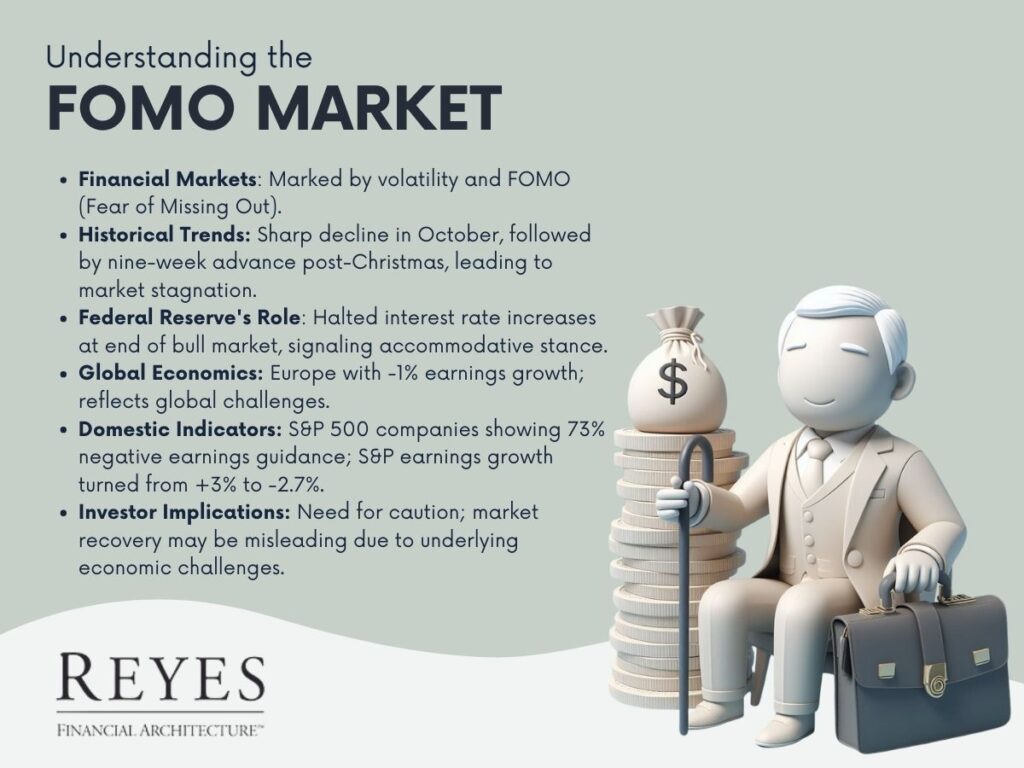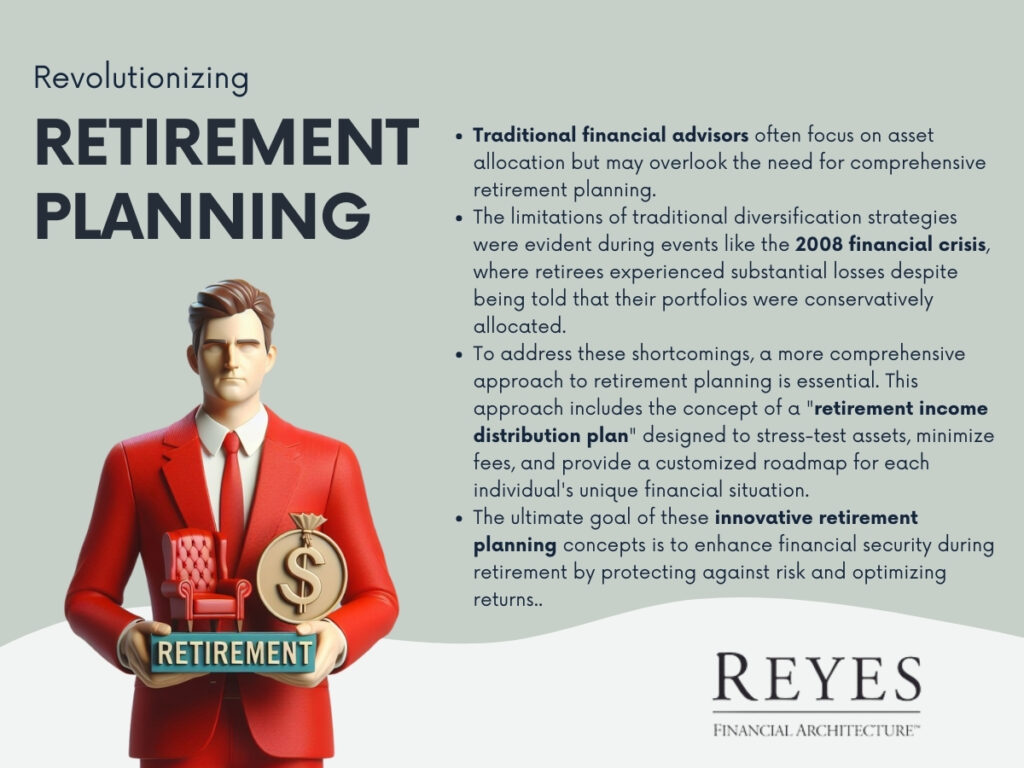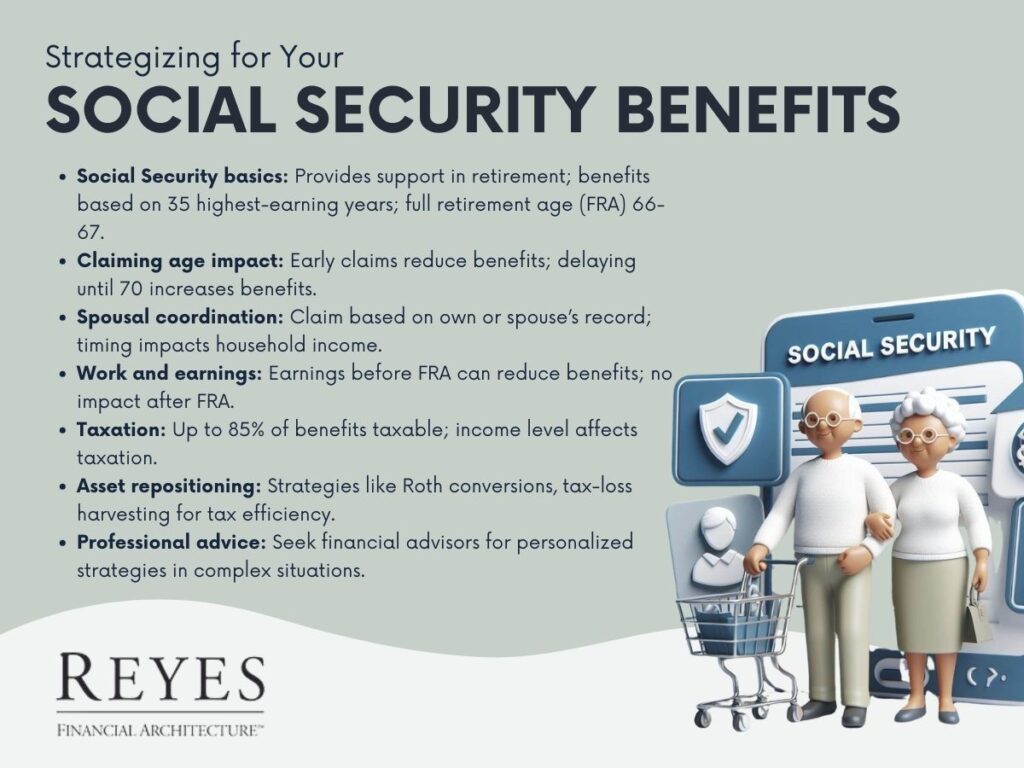In recent times, the financial markets have been characterized by significant volatility and unpredictability, often leading investors to experience what is popularly known as the FOMO (Fear of Missing Out) Market. This term aptly encapsulates the anxiety and urgency that investors feel in the face of rapidly changing market conditions, driven by the fear of missing out on potential gains.

Historically, October of the previous year marked one of the worst performances since 1931, followed by a nine-week continuous advance in the market post-Christmas. This pattern of a sharp decline followed by a rapid ascent has essentially led to a stagnation in market progress over the past year and a half.
The last quarter of the year saw the market in a precarious position, facing challenges from various fronts. However, the Federal Reserve's intervention played a pivotal role in altering this trajectory. The Fed's decision to halt interest rate increases towards the end of a bull market was an unprecedented move, breaking away from traditional monetary policy patterns. This cessation is particularly notable as the market technically entered a bear phase, with a 20% drop from its peak.
The Federal Reserve's actions are crucial in understanding market dynamics. Typically, the Fed raises interest rates to curb inflation and stabilizes the economy, but in this case, they chose a different path. By not increasing rates, the Fed essentially signaled a more accommodative monetary stance, which historically tends to boost market confidence and investment.
Globally, Europe exhibited negative earnings growth in the last year, with a decline of about 1%. This is significant as it reflects broader economic challenges beyond the United States. In the domestic context, nearly all S&P 500 companies have reported their earnings, with a staggering 73% providing negative earnings guidance. This indicates a pessimistic outlook for the future, with expectations of performance being worse than the present.
The S&P earnings growth, which was estimated at 3% in December, has now turned negative, standing at -2.7%. This downturn is particularly stark, considering the record-high earnings growth witnessed in 2018.
These market conditions underscore the need for caution among investors. The rapid recovery of the markets from recent losses might create an illusion of stability and growth. However, the underlying economic indicators suggest otherwise. The volatility is likely to persist, and it's crucial for investors to be prepared for this uncertainty.
Investors are advised to develop a comprehensive understanding of the risks associated with their portfolios. This involves not only a keen awareness of market trends but also a thorough assessment of individual investment objectives, risk tolerance, and long-term financial goals.
In conclusion, navigating the FOMO Market requires a balanced approach, blending caution with opportunity. Understanding the broader economic context, staying informed, and aligning investment strategies with individual risk profiles are key to successfully managing investments in these volatile times. Investors should remain vigilant, adaptable, and informed to make the most out of the opportunities that arise, while safeguarding their investments against potential downturns
Welcome, readers, to this insightful article on revolutionizing retirement planning. In today's discussion, we will explore key concepts from a recent book focusing on retirement preparation. Over a series of articles, we will delve into the core principles that aim to reshape how we approach retirement.

In 1995, one individual entered the financial advisory business with dreams of making a difference in the lives of retirees. Little did they know that a deeply personal experience would significantly impact their outlook on financial planning. This poignant story demonstrates the importance of comprehensive retirement planning.
Many individuals may find themselves lacking the necessary knowledge and resources to navigate retirement planning effectively. Traditional financial advisors often concentrate on asset allocation, presenting visually appealing charts that may not provide the best protection against capital loss during retirement.
During the 2008 financial crisis, many retirees discovered the limitations of traditional diversification strategies. Despite being told that a balanced portfolio of stocks and bonds was a conservative approach, they experienced substantial losses. These events highlighted the need for more robust retirement planning.
To address the shortcomings in retirement planning, a more comprehensive and integrated strategy is essential. This approach goes beyond traditional asset allocation and introduces the concept of a "retirement income distribution plan." This plan is designed to stress-test assets, minimize fees, and provide a customized roadmap for each individual's unique financial situation.
Diversification should extend beyond asset classes and encompass various investment strategies. For instance, real estate investments can provide stability since they often perform independently of the stock market. By incorporating such non-correlated assets into your portfolio, you can reduce vulnerability during market downturns.
Diversification alone may not be enough to protect your portfolio during market volatility. Implementing risk management strategies is crucial. One such strategy is a "stop loss" mechanism, which caps losses at a predetermined percentage. This approach acts as a safeguard against significant portfolio declines during turbulent market conditions.
In this article, we have explored innovative concepts in retirement planning that aim to improve financial security during one's retirement years. The emphasis has been on comprehensive, integrated planning that surpasses traditional asset allocation.
The goal is to protect against risk and enhance returns for a more secure financial future. Stay tuned for the upcoming articles in this series, where we will delve deeper into these innovative strategies.
Click on the link to watch our interactive video to quickly and simply understand: How to Strategize for your Social Security Benefits.
Social Security serves as a foundational element in many retirement plans, and understanding how to strategize for maximum benefits is crucial. With increasing life expectancies, retirement can last between 20 to 30 years, making Social Security planning more critical than ever. This blog explores the strategies for optimizing Social Security benefits, helping ensure a financially secure retirement.

The Social Security system in the United States is designed to provide financial support to individuals in their retirement years. The amount of benefit one receives is based on their 35 highest-earning years of work. The full retirement age (FRA) – the age at which one is eligible for full benefits – varies from 66 to 67, depending on the birth year.
The age at which you start claiming Social Security benefits significantly impacts the amount received. Claiming benefits at the earliest age of 62 results in a reduction of at least 25% compared to waiting until the full retirement age. Conversely, delaying benefits past the FRA up to age 70 leads to an increase in benefits, with a maximum increase of 32% at age 70.
For example, if the retirement income at age 66 is $2,000 per month, retiring at this age versus waiting until age 70 can mean a difference of over $200,000 over a lifetime. This stark difference underscores the importance of timing in Social Security planning.
Couples have additional strategies available. Spouses can claim benefits based on their work record or receive up to 50% of their spouse’s benefit at full retirement age, whichever is higher. Coordinating the timing of benefit claims can maximize total household Social Security income. For example, the lower-earning spouse might start benefits earlier, while the higher-earning spouse delays benefits to increase the survivor benefit.
Working while receiving Social Security benefits before reaching the full retirement age can temporarily reduce your benefits. Understanding these rules is vital for those planning to work part-time in retirement. After reaching the full retirement age, however, earnings do not affect Social Security benefits.
Up to 85% of Social Security benefits can be taxable, depending on your total income. Planning for tax implications is essential. Strategies like Roth IRA conversions or timing the withdrawal of retirement accounts can impact the taxation of Social Security benefits and overall retirement income.
Repositioning assets to reduce taxable income can lead to more tax-efficient retirement income. This might involve shifting from taxable accounts to Roth IRAs or employing tax-loss harvesting strategies. This repositioning can influence the taxation of Social Security benefits, potentially leading to lower overall tax liabilities.
With over 500 possible combinations of factors affecting benefits, consulting a financial advisor who specializes in Social Security planning is highly recommended. An advisor can offer customized strategies based on individual circumstances and help navigate the complex rules of the Social Security system.
Social Security planning should be a personalized process, reflecting individual work histories, health status, family circumstances, and retirement goals. The decision on when to claim benefits is a pivotal one, with long-lasting financial implications.
Understanding the nuances of the Social Security system and employing strategic planning can make a significant difference in retirement income, ensuring a more secure and comfortable retirement phase.
As retirements grow longer, the importance of maximizing Social Security benefits cannot be overstated. It's not just about when to start claiming benefits but how to integrate them with other retirement income sources, tax planning, and spousal benefits. Informed decisions and strategic planning in this arena are invaluable for achieving a financially stable and fulfilling retirement.